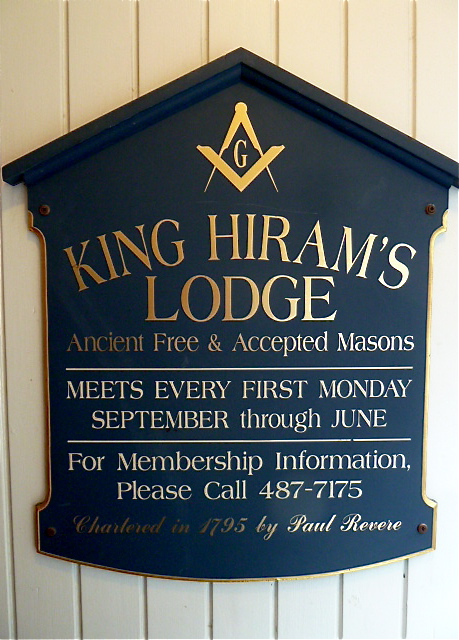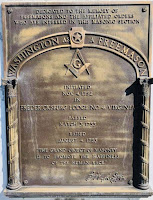If you define a vacation as the act of taking off several days (at least) from work, traveling a notable distance – and one outside your usual orbit – and settling in at one location (at least) for recreation and nothing but, then last week I took my first vacation since the summer of 1994. (Yeah. I know that’s 18 years.)
Provincetown, Massachusetts was my family’s vacation spot every August in the 1970s when I was a child, and it was there I returned for 72 hours of sightseeing, seafood dining, beer tasting, and cigar smoking. The sightseeing included visiting several places of Masonic interest right in the middle of town.
The first stop was obvious: Masonic Place, the address of King Hiram’s Lodge, chartered in 1795 by none other than Paul Revere, Grand Master.
 |
| In Provincetown, street signs can be found wherever. |
 |
| Had I arrived a day earlier, I could have visited the lodge. |
 |
Every square foot on Commercial Street is valuable... and occupied. Retail shops, art galleries, inns, restaurants, and other entities are crammed into every possible lot, separated by a network of alleys, driveways, byways, snickelways, and paths. As you can see, King Hiram Lodge has retail space in its frontage, and there is a club in the rear. This Buddhist monk appeared by pure happenstance.
|
 |
Constructed in the first decade of the 20th century, the Pilgrim Memorial Monument towers over Provincetown from its hilltop perch. Its construction began with a Masonic cornerstone-laying ceremony in 1907, and ended with a Masonic consecration in 1910.
|
 |
The Monument stands 252 feet. On the way up, you will see dozens of markers placed by sponsoring societies, municipalities, and others who made construction of the landmark possible. Here is that of the Grand Lodge of Massachusetts.
|
 |
Also on the grounds of the Monument is the Provincetown Museum. Among the artifacts on display are ephemera concerning Masonry’s role in bringing the Monument to fruition. Here is the printed program for the cornerstone-laying ceremony of August 20, 1907.
|
 |
A time capsule was enclosed in the Monument construction. Among its contents is a book of Grand Lodge proceedings from 1907.
|
 |
| An outdoor marker on the grounds of the Monument. |
 |
| As above, so below. |
While surveying the scenery from the top of the Monument, I spotted a cemetery. Visiting Provincetown Cemetery, I did not find any grave markers from the 17th or 18th centuries, as I had hoped, but I certainly did come across a number of Masonic headstones, and some of these were notable.
 |
Bro. McIntosh had the Keystone of Mark Masonry
engraved into his headstone. |
Bro. Francis P. Smith has a monument illustrated with the Beehive, the Square and Compasses, and the three-link chain of Odd Fellowship. The Odd Fellows of Marine Lodge No. 96 were an important force in the social and philanthropic lives of Provincetown.
 |
| Close-up of the emblems. |
 |
| Bro. Joshua P. Atkins has the S&C inside the Mark Master Keystone. |
 |
I do not know if Capt. Ira B. Atkins was a relation
or only a Masonic brother. |


 |
| This one could not escape notice. |
 |
| Bro. Reuben Ryder also has the links of Odd Fellowship with his S&C. |
I photographed other stones, and there were others still that I did not stop to shoot, but you get the idea.
I left town on Friday morning, taking the scenic route for a while, and when passing through Sandwich, I happened across
Dewitt Clinton Lodge, instituted in 1885.
 |
| The lodge building was a church constructed in 1847. |
 |
The brethren will host an open house on October 20.
The lodge is located at 175 Main Street. |
 |
I cannot help but wonder how a street earns the name
Good Templar Place, but there it is in Provincetown.
|

















































































































